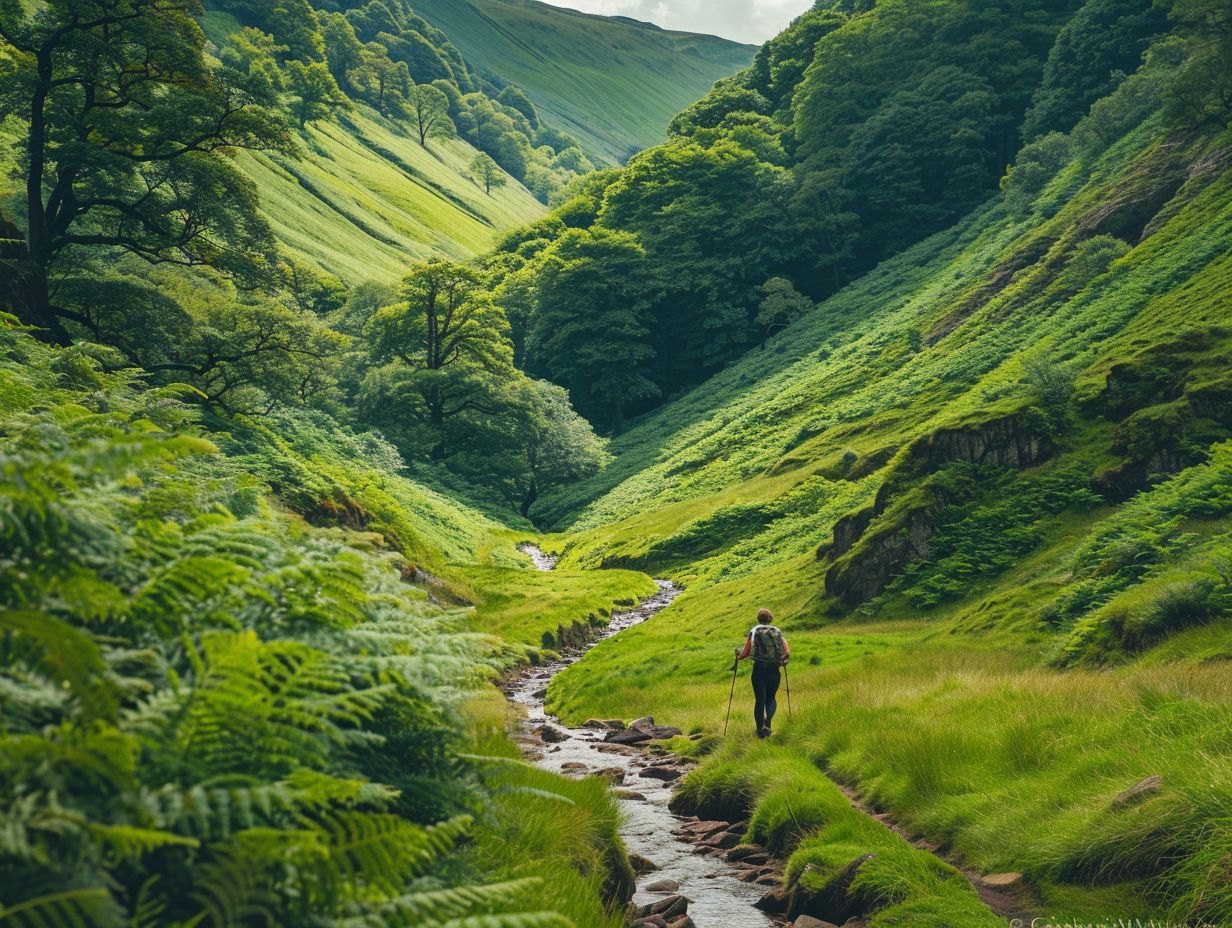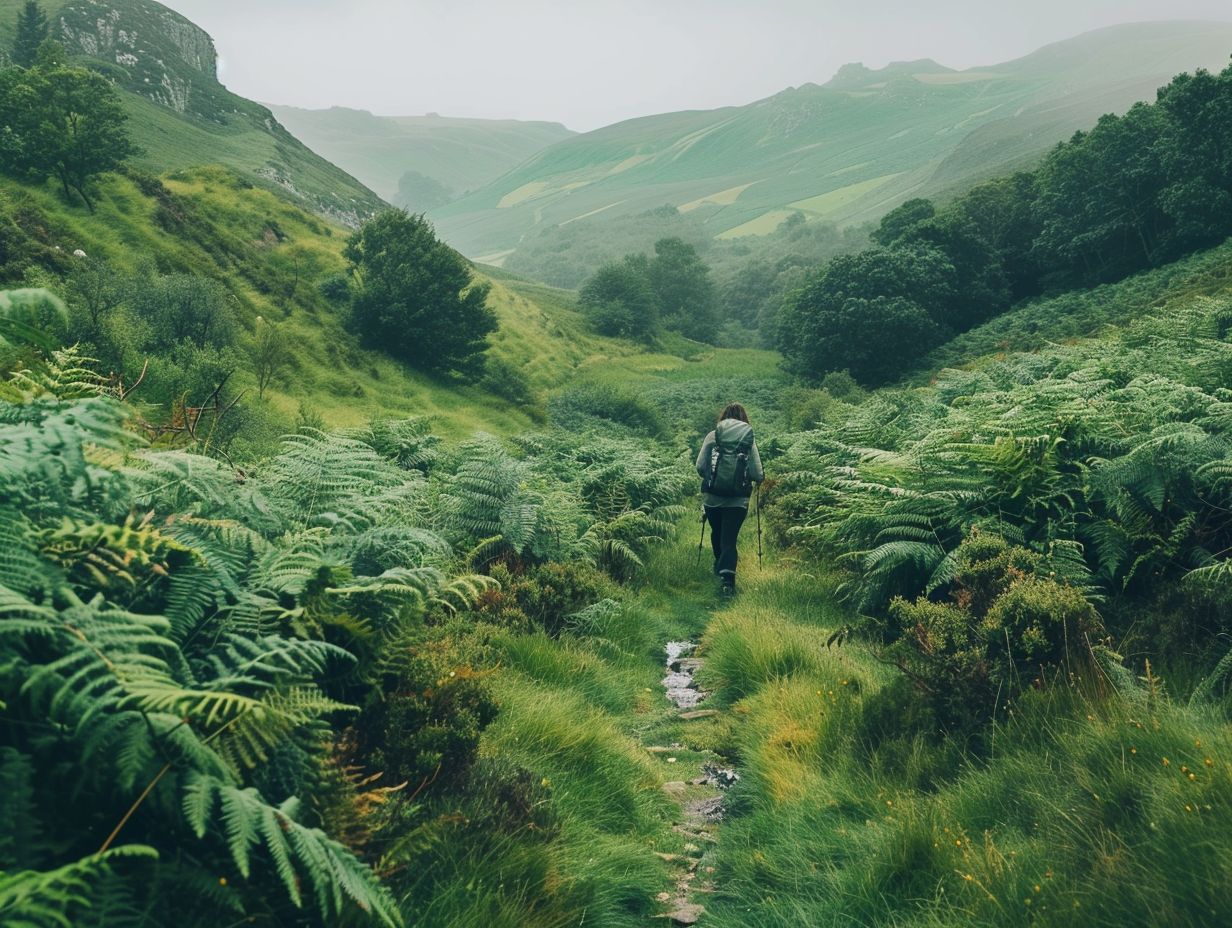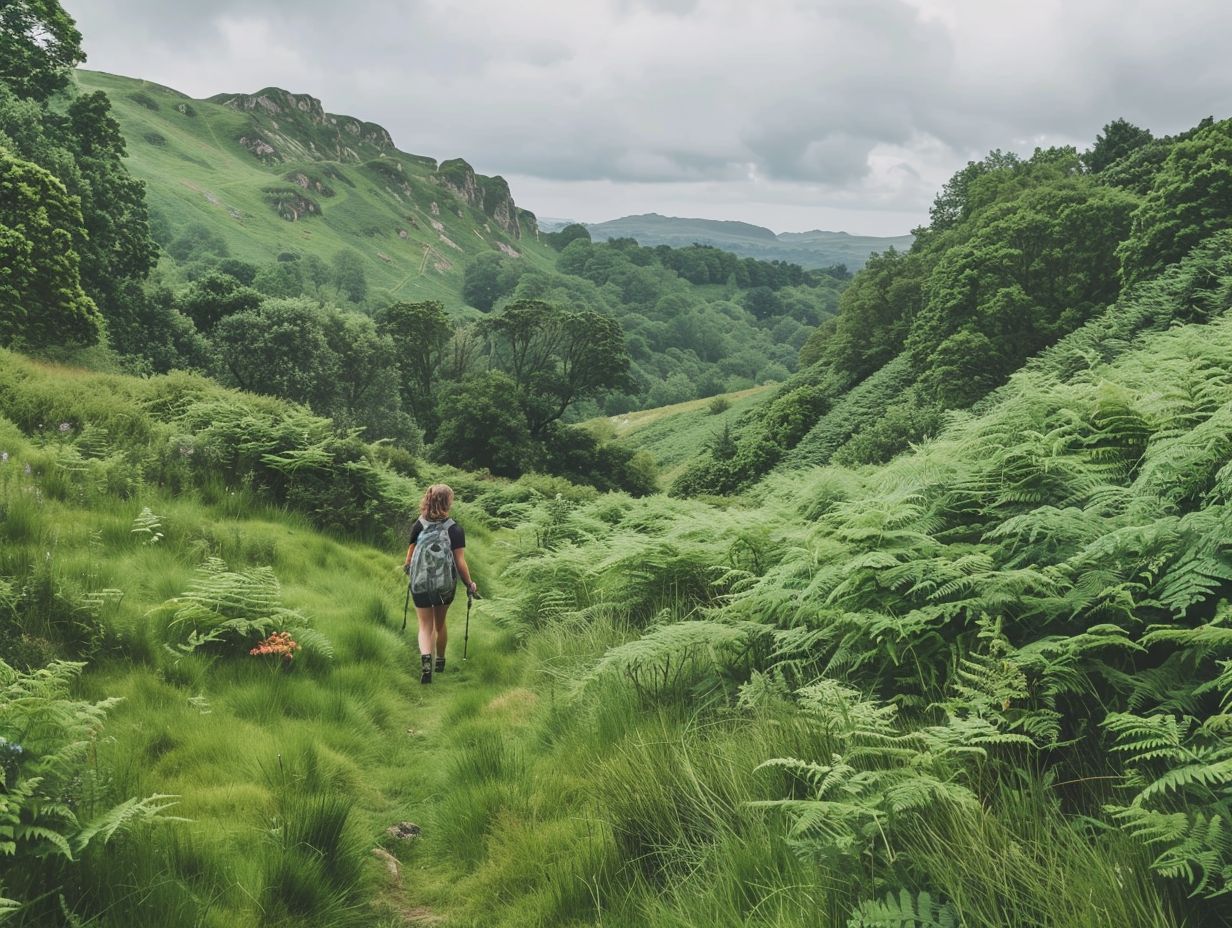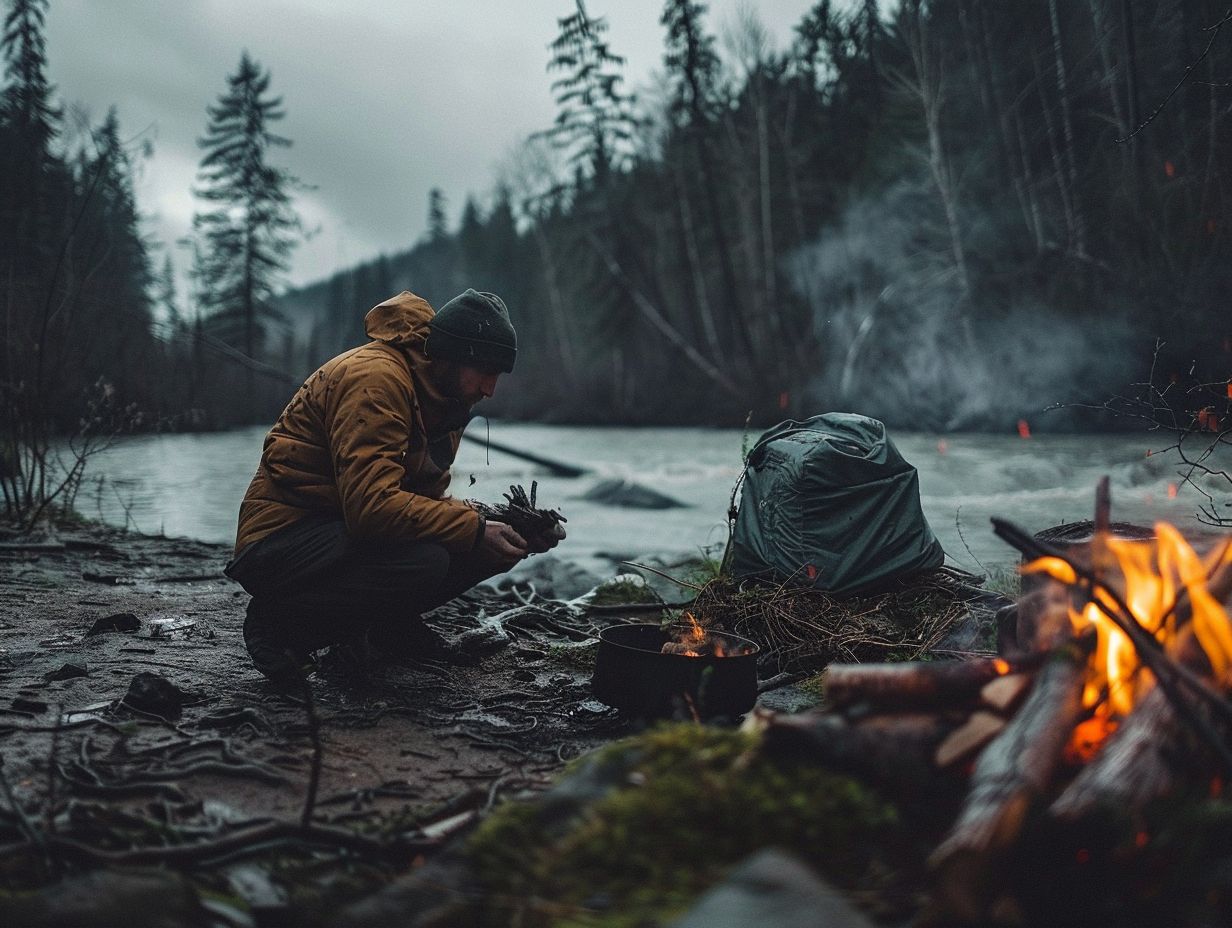Explore the stunning landscapes of the UK’s National Parks through backpacking. When planning your route and ensuring your safety while enjoying the experience, this article contains essential tips to ensure the success of your adventure.
Discover the top National Parks to explore, must-see sights and activities, safety precautions, best times to visit, and common mistakes to avoid.
Prepare to embark on an unforgettable journey and maximise your backpacking experience in the UK!
Key Takeaways:

- Plan your route and accommodations carefully to make the most of your backpacking trip in UK’s National Parks.
- Pack light yet efficiently to ensure a comfortable and hassle-free journey.
- Check the weather forecast and be prepared for all conditions to stay safe and enjoy your experience.
1. Plan Your Route and Accommodations
When embarking on a walking adventure in the UK, meticulous planning of your route and accommodations is crucial to ensure a smooth and enjoyable journey through the diverse landscapes of England.
Selecting the right accommodations based on your budget and preferences can significantly enhance your overall experience. Options such as camping, hostels, and independent barns offer unique experiences, each catering to different needs.
It’s also important to consider proximity to walking trails and national parks when choosing where to stay. Staying close to these locations not only provides convenience but also allows you to maximise your time exploring the natural wonders of the UK countryside.
2. Pack Light and Efficiently
When preparing for your walking expedition in the UK, it is crucial to pack light and efficiently. This will ensure that you can navigate the trails and countryside comfortably without being weighed down by unnecessary items.
To accomplish this, it is recommended that you select lightweight, multipurpose gear. This includes a high-quality rucksack with adjustable straps and ample compartments to keep your essentials organised.
Additionally, consider investing in a compact yet durable tent, a lightweight sleeping bag, and a portable stove for preparing meals on the go.
Packing versatile clothing items that can be layered for different weather conditions will help you remain comfortable throughout your trek. To optimise space and reduce strain on your back, use packing cubes or compression sacks to organise your belongings efficiently in your rucksack. This will also make it easier for you to access your items when needed.
3. Check the Weather and Prepare for All Conditions
Before setting off on your walking journey in the UK, it is vital to stay informed about the weather forecast and adequately prepare for varying conditions, including rain, sun, and wind, to ensure your safety and comfort throughout the trip.
Your preparation should involve packing essential weather-appropriate clothing and gear, such as waterproof layers to shield against unexpected showers and protective sun gear to prevent sunburn. Monitoring weather updates regularly during your trip is crucial to adapt your plans accordingly.
In the UK, weather conditions can change rapidly, so being flexible with your itinerary and having contingency plans in place can help you navigate through adverse weather conditions smoothly and make the most of your walking experience.
4. Follow Leave No Trace Principles
When exploring the scenic beauty of the UK’s national parks and trails, it is essential for you to adhere to the Leave No Trace principles to minimise your environmental impact, promote conservation, and uphold the natural integrity of the landscapes for future generations.
Part of this responsibility includes practising proper waste disposal by packing out all rubbish, including food scraps and biodegradable items, to maintain the cleanliness of the environment.
By respecting wildlife and observing from a safe distance without feeding or approaching them, you contribute to the preservation of their natural behaviours and habitats undisturbed.
Staying on designated trails not only ensures your safety but also protects fragile ecosystems from unnecessary damage caused by human foot traffic.
By following these sustainable practices, you, as an outdoor enthusiast, can responsibly enjoy the beauty of nature.
5. Be Aware of Wildlife and Their Habits
When traversing the picturesque countryside and trails of the UK, it is essential for you to be mindful of the diverse wildlife inhabiting these areas. Understanding the habits and behaviours of these wildlife species is crucial for ensuring your safety and the preservation of the natural ecosystem.
One common wildlife species you may encounter in UK national parks is the red deer. These majestic creatures are the largest land mammal in the UK and are most active during dawn and dusk. When observing red deer, it is important to maintain a safe distance and never approach or feed them.
Additionally, be cautious around nesting birds such as pheasants and grouse, especially during the breeding season to avoid disturbing their nests. By respecting the wildlife’s space and following designated trails, you can enjoy a memorable wildlife viewing experience while simultaneously keeping both animals and visitors safe.
6. Bring Proper Navigation Tools
When navigating the intricate network of trails and paths in the UK’s national parks, it is essential to have the right set of navigation tools at your disposal. Tools such as maps, compasses, and GPS devices are crucial in ensuring that you remain on course and safely reach your intended destinations.
A solid understanding of map reading skills is vital for any hiking excursion. The ability to interpret contour lines, symbols, and scales on a map allows you to effectively plot your route and make informed decisions throughout your journey.
Additionally, being able to recognise and interpret trail markers, including signposts, waymarks, and cairns, can offer valuable guidance and reassurance as you traverse diverse terrains.
When preparing for a long-distance hike, it is imperative to acquaint yourself with the route in advance. Take note of key landmarks, water sources, and potential hazards to prevent getting lost or disoriented during your trek. Familiarising yourself with these details will help ensure a safe and successful hiking experience.
Know the Rules and Regulations of the National Park

It is crucial for you to familiarise yourself with the rules and regulations governing the UK’s national parks to ensure a respectful and responsible outdoor experience whilst honouring the natural and cultural heritage of these protected areas.
When camping in national parks in the UK, it is imperative that you adhere to designated camping areas and restrictions in order to minimise your environmental impact.
Observing trail etiquette is essential for preserving the integrity of these pristine landscapes, as it encourages visitors to remain on marked paths to safeguard delicate ecosystems.
Conservation guidelines emphasise the importance of practising leave-no-trace principles, correctly disposing of waste, and showing respect for wildlife habitats.
By following these regulations, you are actively contributing to the long-term conservation of these natural treasures, preserving them for future generations to appreciate.
Stay hydrated and bring a water filter.
Maintaining proper hydration levels during your walking adventures in the UK is crucial for your well-being and stamina, so remember to carry an adequate water supply and a reliable water filter to access clean drinking water along the way.
Proper hydration is essential to prevent dehydration and heat-related illnesses, especially when exploring diverse terrains like forests, mountains, or coastal paths.
By using a water filter, you can safely obtain drinking water from streams, rivers, or lakes without worrying about contaminants. Remember to drink small amounts frequently rather than gulping down large quantities at once to optimise hydration and keep your energy levels up during your hiking expeditions.
Be Prepared for Limited Cell Service
When venturing into the remote and scenic landscapes of the UK for walking expeditions, you should anticipate encountering limited mobile service in certain areas. It is crucial for you to be prepared with alternative communication methods and emergency plans to ensure your safety.
One effective way to mitigate the risks associated with poor mobile reception during your hike is to carry a satellite phone or an emergency beacon. These devices can serve as a vital lifeline in case of emergencies when traditional mobile service is unavailable.
Additionally, before embarking on your journey, it is important to inform a friend or family member of your planned route and expected return time. This step is essential for ensuring that someone is aware of your whereabouts and can raise the alarm if you do not return as scheduled.
Pack Appropriate Clothing and Gear
When you are preparing for your walking escapades in the UK, selecting appropriate clothing and gear is crucial. This will ensure that you remain comfortable, protected, and ready for the varying weather conditions and terrain challenges that you may face during your journey.
When dressing for outdoor activities in the UK, it is important to focus on layering. Begin with a moisture-wicking base layer to keep sweat away from your skin. Add insulating layers, such as fleeces or down jackets, to maintain warmth.
For outer layers, choose weatherproof jackets and pants to provide protection from rain and wind. When selecting footwear, opt for sturdy hiking boots with good ankle support and waterproofing to handle wet conditions.
Having the correct clothing and gear is essential for enhancing your experience during outdoor adventures in the UK.
7. Bring a First Aid Kit
When undertaking walking excursions in the UK, it is crucial to carry a well-equipped first aid kit to ensure you are prepared to handle any minor injuries, emergencies, or unexpected health issues that may arise during your journey.
Your first aid kit for walkers should include essential items such as adhesive plasters, gauze pads, antiseptic wipes, adhesive tape, tweezers, scissors, disposable gloves, a thermal blanket, painkillers, and blister plasters.
Plus having the necessary supplies in your first aid kit, it is important to have knowledge of basic first aid procedures for treating cuts, sprains, and insect bites. Familiarising yourself with emergency protocols, including how to call for help in the event of a severe injury or how to administer CPR in a life-threatening situation, is also crucial for your safety and the safety of others.
Being well-prepared with a properly stocked first aid kit and knowledge of first aid procedures and emergency protocols can make a significant difference in ensuring your safety during outdoor adventures.
Inform Someone of Your Itinerary
Before beginning your walking expedition in the UK, it is essential to always inform a trusted individual of your detailed itinerary. This should include your planned routes, stops for accommodation, and expected return times. By doing so, you can ensure your safety and receive prompt assistance in case of emergencies.
This practice is critical as it provides someone at home with a clear understanding of your whereabouts and plans.This enables them to act quickly in the event of any unforeseen circumstances.
When creating your itinerary, remember to include contact information for your accommodation, emergency contact numbers, and any alternative routes or backup plans.
Develop a habit of sending periodic check-in messages to your designated contact. This will help you update them on your progress and any deviations from the initial plan, ensuring effective communication throughout your journey.
Be Mindful of Your Impact on the Environment
Respecting and minimising your impact on the pristine environment of the UK’s natural landscapes is crucial for preserving their beauty, biodiversity, and ecological balance for future generations of walkers and outdoor enthusiasts.
When you adopt eco-friendly practices while exploring these stunning landscapes, you actively contribute to conservation efforts. Simple actions such as picking up litter along your path not only improve the cleanliness of the surroundings but also safeguard wildlife from harm.
It’s essential to remain on designated paths to prevent soil erosion and avoid disturbing native vegetation. Supporting local conservation initiatives through donations or volunteering can play a significant role in maintaining the delicate balance of nature in these regions.
Respect the Local Culture and Communities

Whilst traversing through the diverse landscapes of the UK, it is important for you to respect and engage with the local culture, traditions, and communities you encounter along your walking routes, fostering mutual appreciation and understanding.
By immersing yourself in the local customs and respecting the heritage sites you visit, you can contribute positively to the preservation of these invaluable assets.
Responsible tourism entails your participation in community-led initiatives, such as supporting local businesses or engaging in cultural exchanges, to ensure that the interactions are mutually beneficial.
Learning about the history and significance of the places you visit not only enriches your experience but also allows for a deeper connection with the destinations you explore.
Have Fun and Enjoy the Experience!
When you embark on your journey through the natural wonders of the UK, don’t forget to enjoy yourself. Immerse yourself in the unique experiences, moments of discovery, and serene beauty that each step of your memorable walking journey offers.
As you venture into the picturesque landscapes, it’s important to be fully present in the moment. Take the time to appreciate the sights, sounds, and scents that envelop you. Engage your senses by feeling the earth beneath your feet, listening to the rustling of leaves overhead, and breathing in the fresh, crisp air.
Embrace the spirit of adventure that accompanies each new path you take, allowing yourself to release any worries and truly connect with the natural world.
Pay attention to the intricate details – whether it’s the vibrant wildflowers or the melodic chirping of birds – that enhance the depth and richness of your walking experience.
What Are the Top National Parks to Backpack in the UK?
Explore the top national parks in the UK that present stunning landscapes, diverse trails, and exceptional backpacking opportunities for outdoor enthusiasts looking for immersive adventures in the heart of England’s natural beauty.
From the rugged terrain of Snowdonia National Park in Wales to the serene beauty of the Lake District in northwest England, each park showcases a distinctive charm and allure.
Snowdonia is renowned for its majestic peaks, such as Mount Snowdon, offering a challenge for seasoned hikers. Conversely, the Lake District provides a network of picturesque trails around its iconic lakes, like Windermere and Ullswater. Camping options vary from wild camping in designated areas to established campsites with amenities.
Noteworthy attractions include the scenic villages scattered across the parks and ancient ruins that lend a historical touch to your outdoor adventures.
What Are the Must-See Sights and Activities in Each National Park?
Discover the must-see attractions and engaging activities that each national park in the UK has to offer, from historic landmarks and scenic viewpoints to thrilling outdoor adventures and cultural experiences that showcase the rich tapestry of England’s natural and heritage wonders.
Embark on guided tours through lush forests and meandering trails, where knowledgeable guides will provide insights into the park’s history and ecosystems.
Make sure to keep an eye out for a variety of wildlife species such as red deer, otters, and rare birds that inhabit these parks. For a more immersive experience, you can participate in wildlife spotting excursions or birdwatching sessions to observe these magnificent creatures in their natural environments.
Be sure not to miss the opportunity to discover hidden gems like secluded waterfalls, ancient ruins, and serene picnic spots that offer moments of tranquillity and contemplation amidst the unspoilt beauty of nature.
How Can One Stay Safe While Backpacking in the UK’s National Parks?
When backpacking through the UK’s national parks, prioritise your safety and well-being by adhering to essential safety precautions, preparing for emergencies, and recognising the potential risks associated with outdoor adventures in diverse terrains.
One critical safety measure for backpackers is to always carry a well-equipped first aid kit containing supplies like bandages, antiseptic wipes, and painkillers.
It is essential to share your travel itinerary with a trusted individual, particularly if you intend to explore off the conventional paths. Understanding the local wildlife and their habitats can assist you in avoiding potentially dangerous encounters.
Stay informed about weather forecasts and pack accordingly, including suitable clothing layers for various conditions. Utilise proper navigation tools such as a map, compass, or GPS device to ensure you stay on course throughout your expedition.
What Are the Best Times to Visit the National Parks in the UK?
Consider the optimal times to visit the enchanting national parks of the UK, taking into account seasonal variations, weather patterns, and crowd levels in order to customise your walking excursions for the best possible conditions and immersive outdoor experiences.
During spring, the parks burst with vibrant colors as blossoming flowers and fresh greenery come to life, providing picturesque scenery ideal for nature enthusiasts and photographers looking to capture the rejuvenation of the landscape.
Summer beckons adventurers with longer daylight hours, perfect for extended hikes, camping under the starry skies, and basking in the warm sunshine at scenic viewpoints.
As autumn approaches, witness the stunning transformation of foliage into a fiery display of reds, oranges, and yellows, creating a breathtaking canvas of nature’s artistry.
In winter, experience a serene ambiance as snow-dusted trails offer peaceful solitude and the opportunity to admire the architectural beauty of the parks in a tranquil setting.
What Are Some Common Mistakes to Avoid When Backpacking in the UK’s National Parks?
Avoid common mistakes and pitfalls to enhance your backpacking experiences in the UK’s national parks, ensuring smoother journeys, safer adventures, and more fulfilling explorations of the diverse landscapes and trails that await outdoor enthusiasts.
One prevalent error backpackers often make is underestimating the importance of thorough route planning. Before setting off on your trek, take the time to study maps, familiarise yourself with the terrain, and check for any potential hazards or closures. Ensure you have the appropriate gear for the season and conditions you’ll encounter.
Another common mistake to avoid is overlooking safety measures such as carrying a first aid kit, emergency supplies, and informing someone of your itinerary. Being mindful of Leave No Trace principles is crucial for preserving the natural beauty of these parks for future generations.
Frequently Asked Questions

What should I pack for a backpacking trip in the UK’s National Parks?
It is important to pack lightweight and versatile clothing, a sturdy pair of hiking boots, a good quality backpack, a map and compass, a first-aid kit, and plenty of water and high-energy snacks. It is also recommended to pack rain gear and warm layers, as weather in the UK can be unpredictable.
Do I need to have prior backpacking experience to hike in the UK’s National Parks?
While prior backpacking experience is helpful, it is not necessary. Many of the trails in the UK’s National Parks are suitable for beginners, but it is important to research and plan your trip beforehand, and be prepared for some challenging terrain.
Are there any camping restrictions in the UK’s National Parks?
Each National Park in the UK may have different camping restrictions, so it is important to check with the specific park’s website before your trip. In general, wild camping is not allowed and you must camp in designated areas or campsites.
Can I bring my dog with me on a backpacking trip in the UK’s National Parks?
Some National Parks in the UK allow dogs on certain trails, but they must be kept on a leash at all times. It is important to research the specific park’s rules and regulations regarding pets before bringing your furry companion on a backpacking trip.
How can I minimise my impact on the environment while backpacking in the UK’s National Parks?
It is crucial to follow the Leave No Trace principles while backpacking in the UK’s National Parks. This includes packing out all trash, using designated campsites, and being respectful of wildlife and vegetation. Avoid using single-use plastic and opt for eco-friendly alternatives.
What are some tips for staying safe while backpacking in the UK’s National Parks?
Always check the weather forecast before your trip and be prepared for changing conditions. Make sure to tell someone your itinerary and expected return time, and bring a fully charged phone or a way to contact emergency services. It is also important to bring a map and compass and know how to use them, in case you get lost on the trail.



